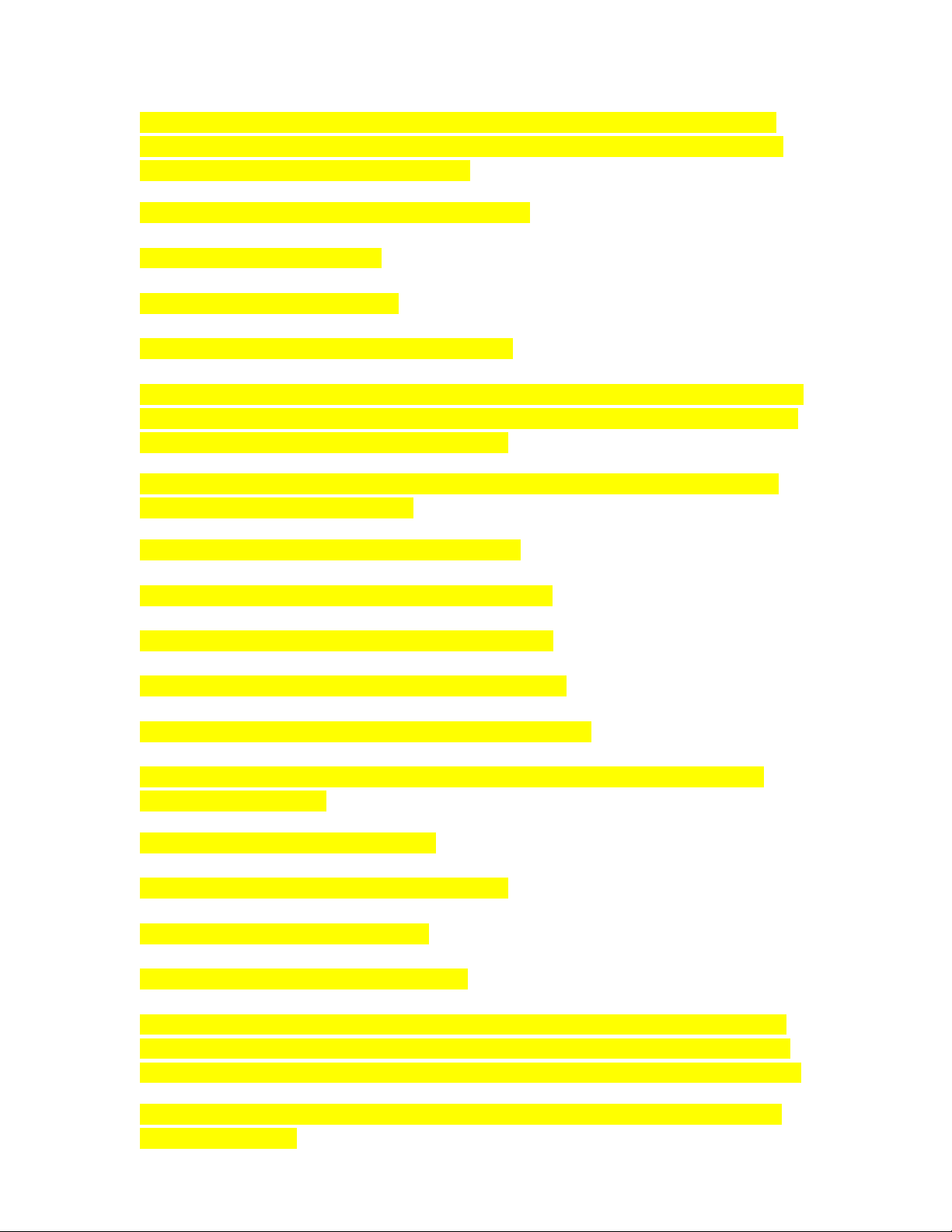
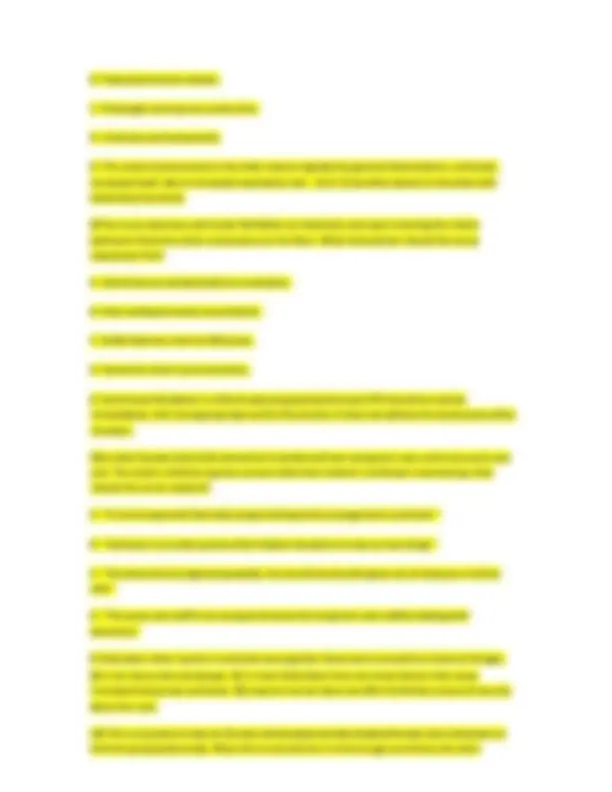
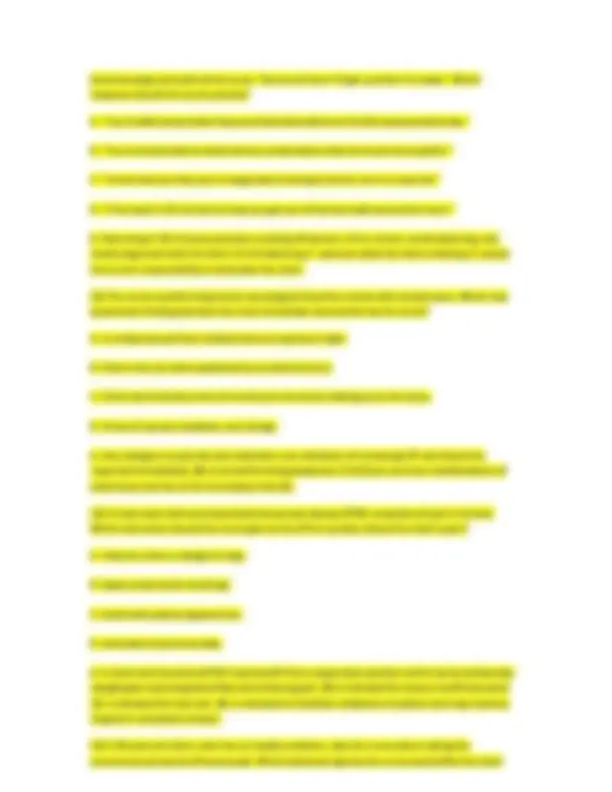
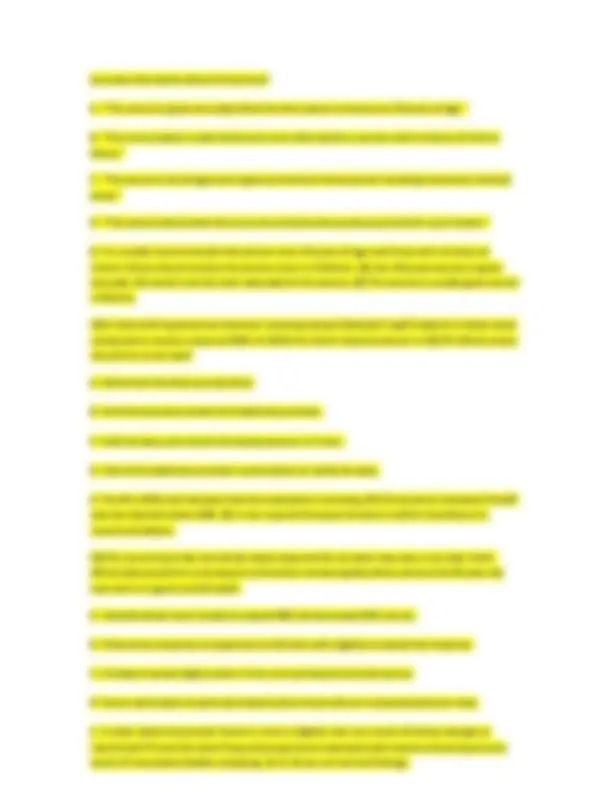
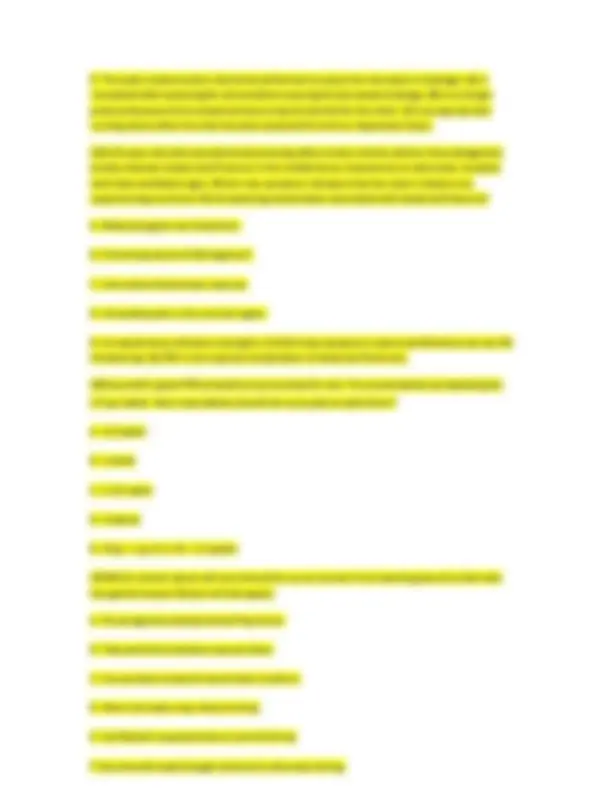
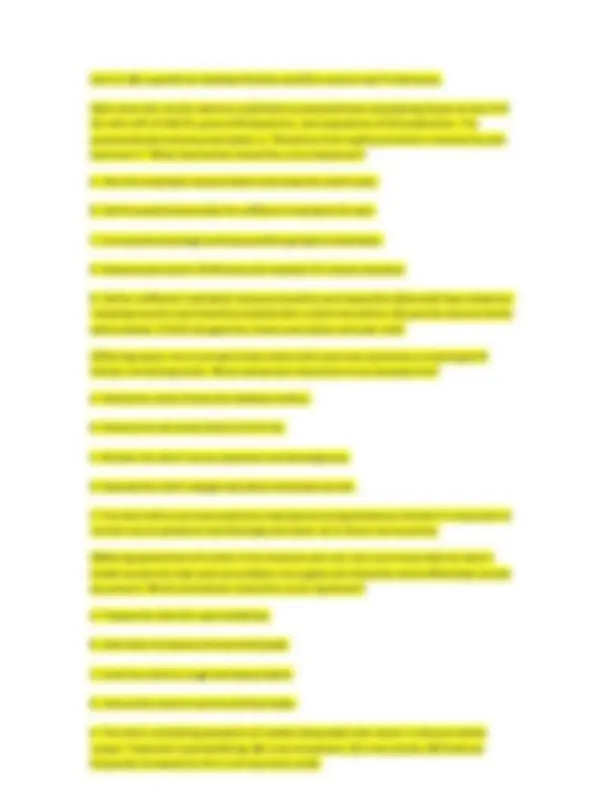
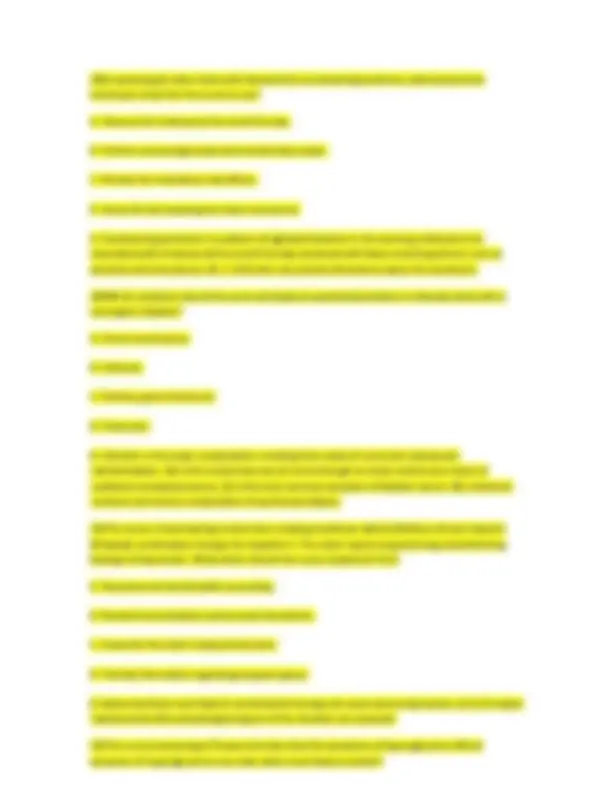
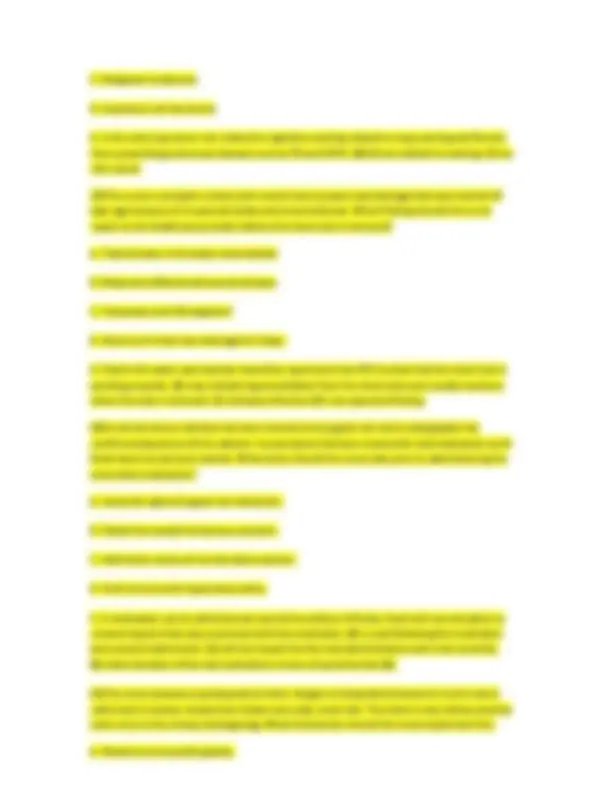
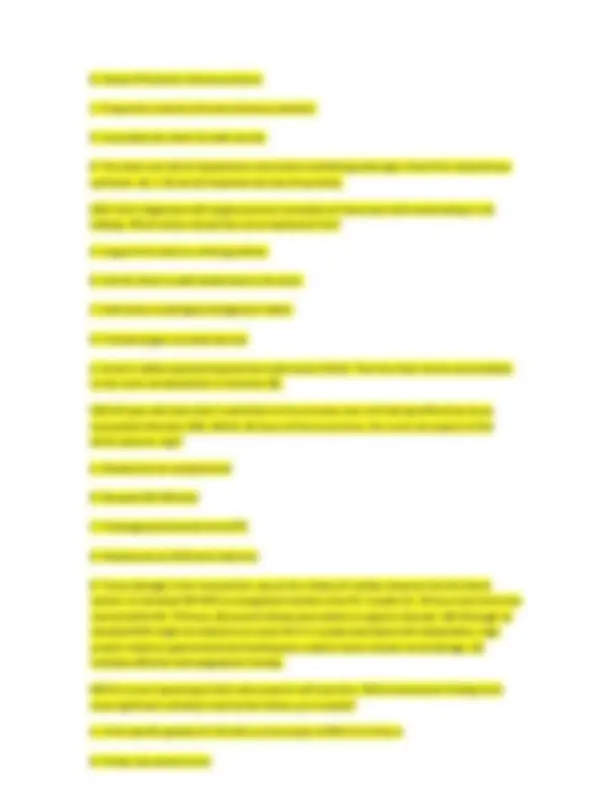
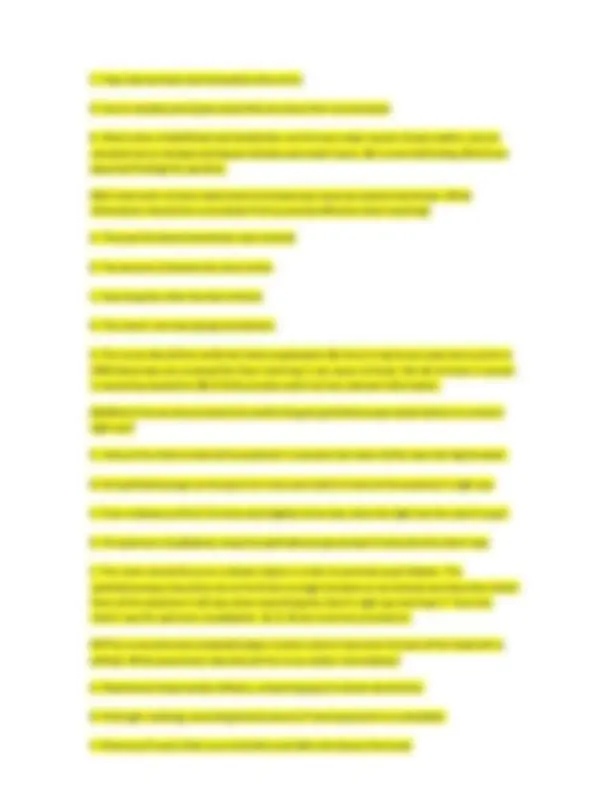
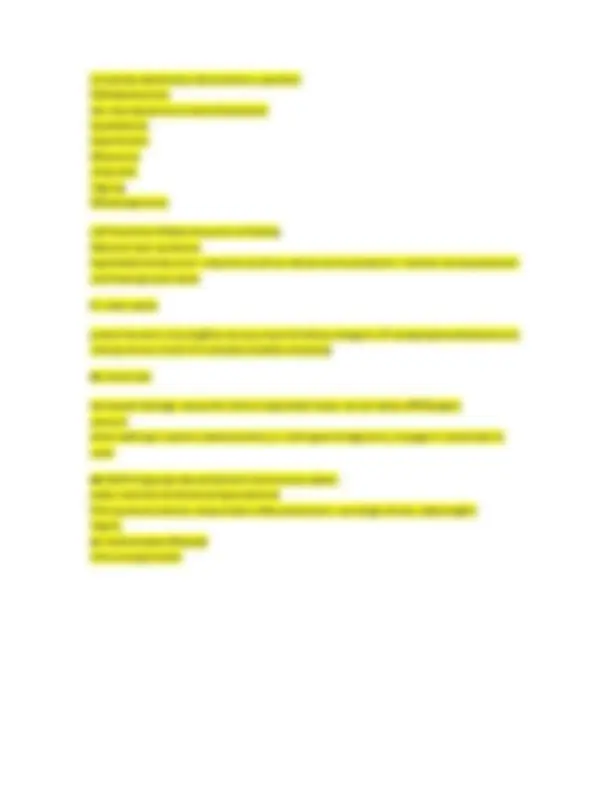
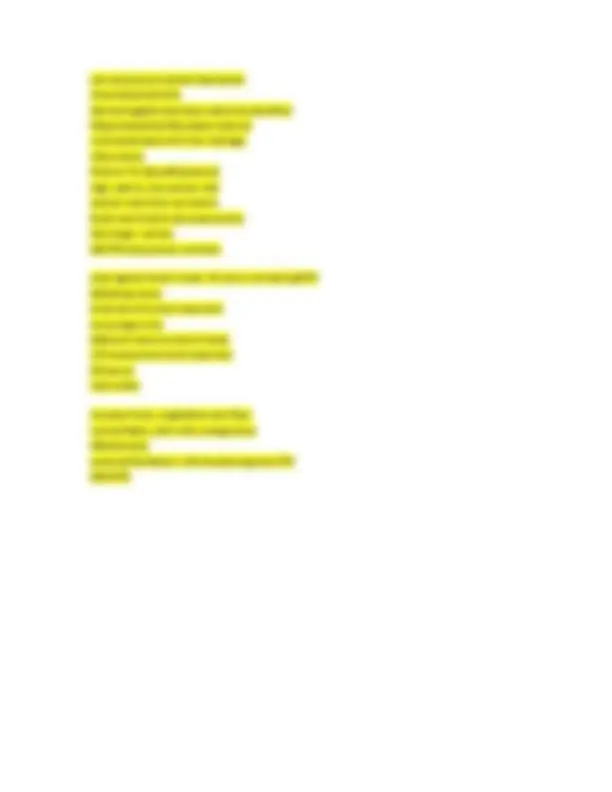
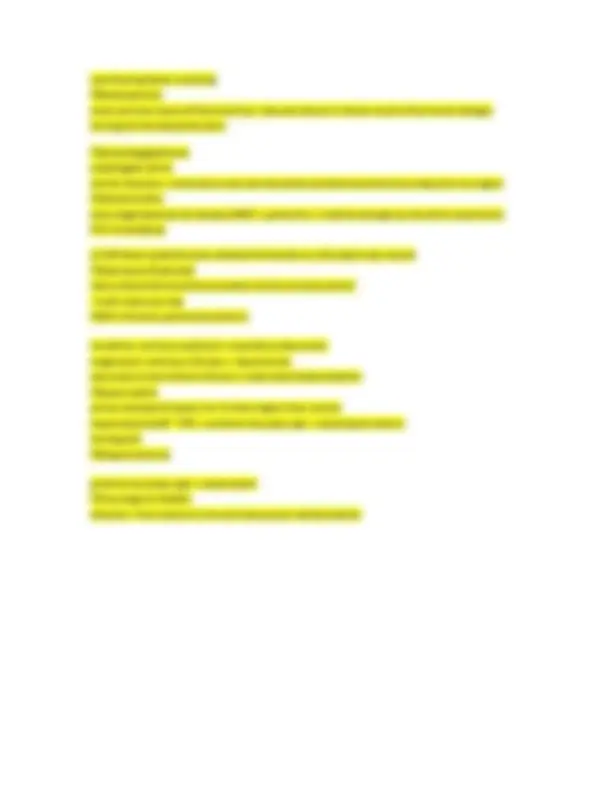
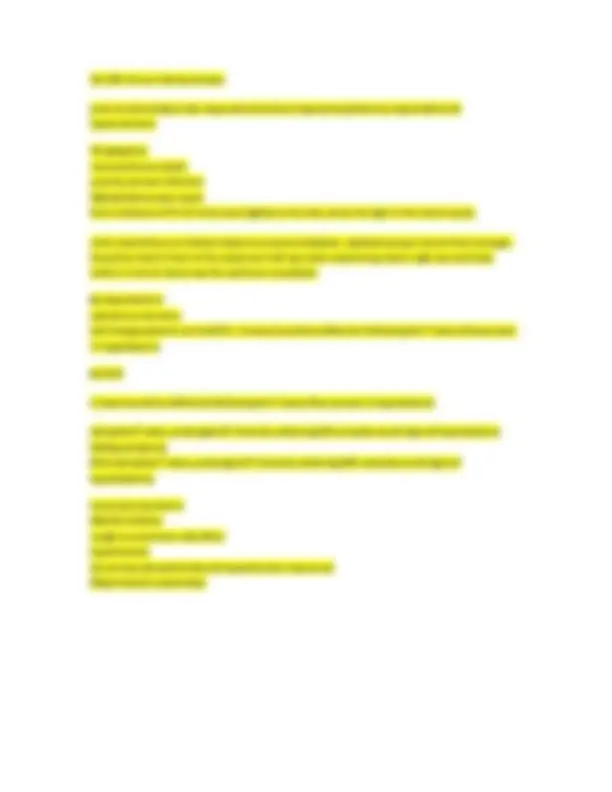
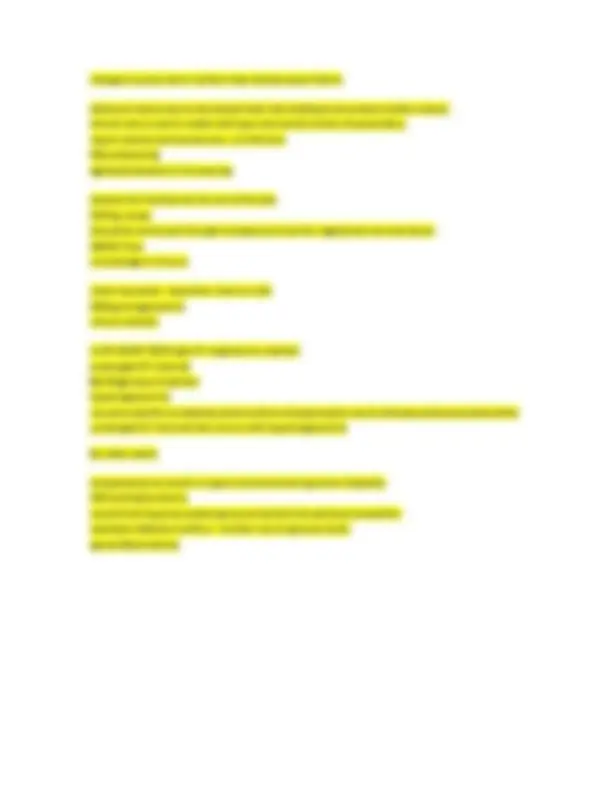
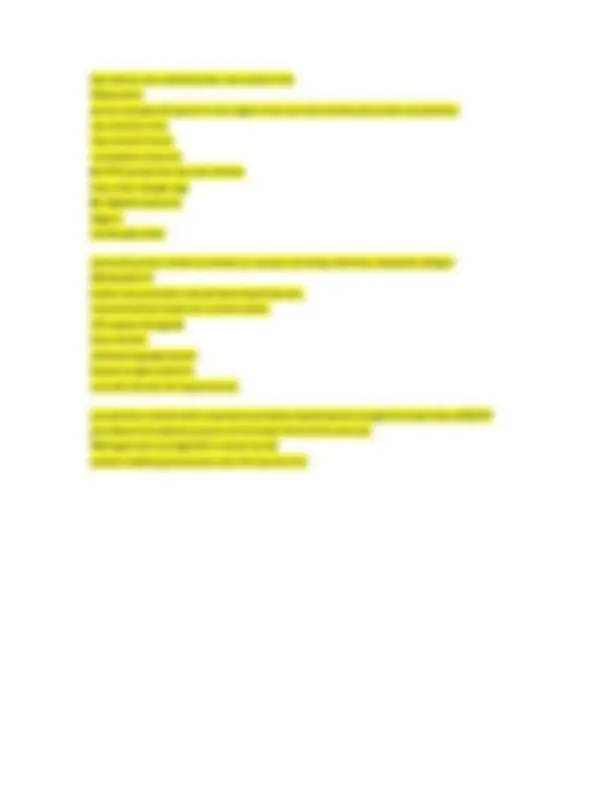
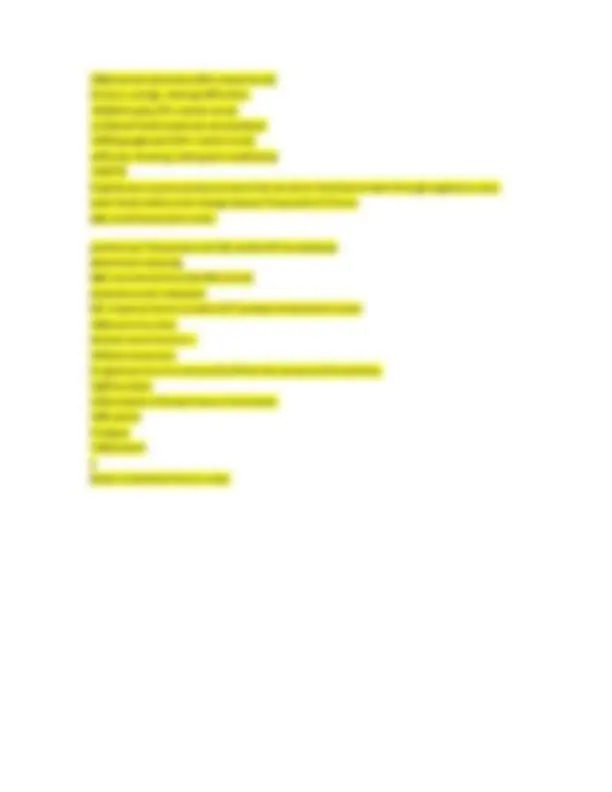
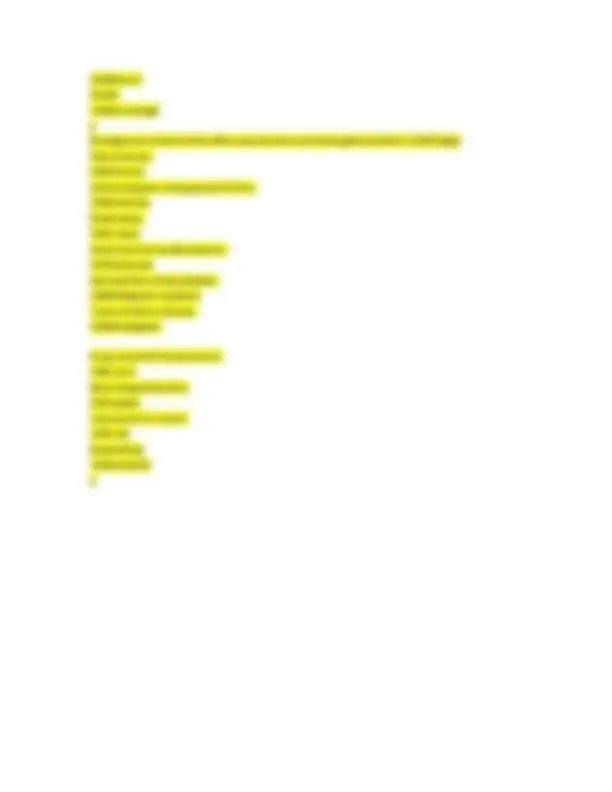
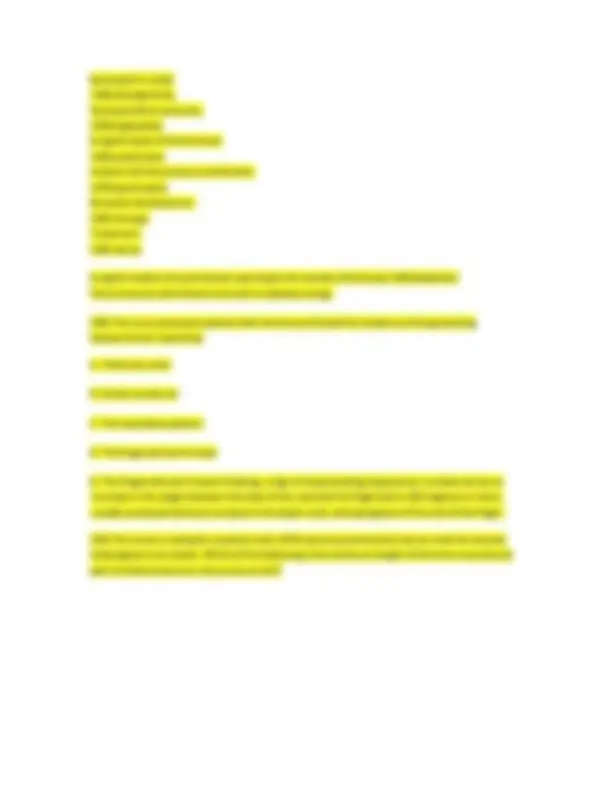
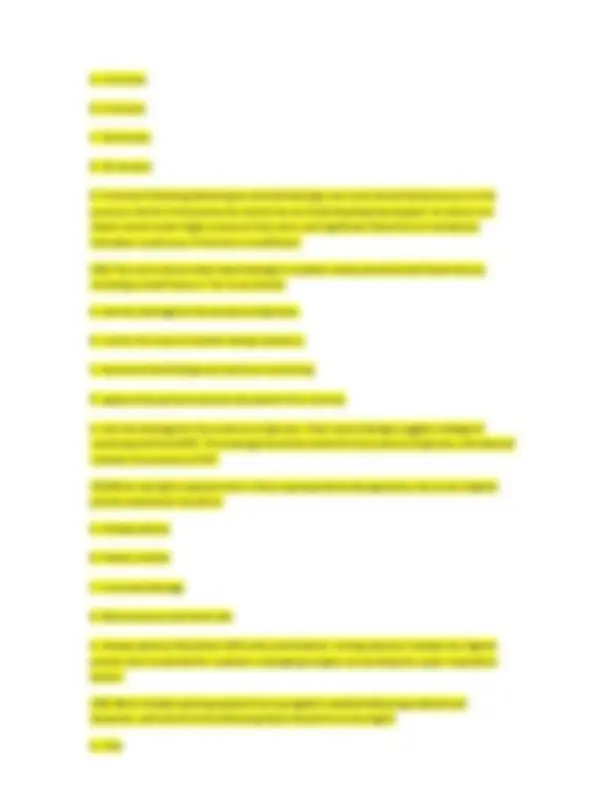
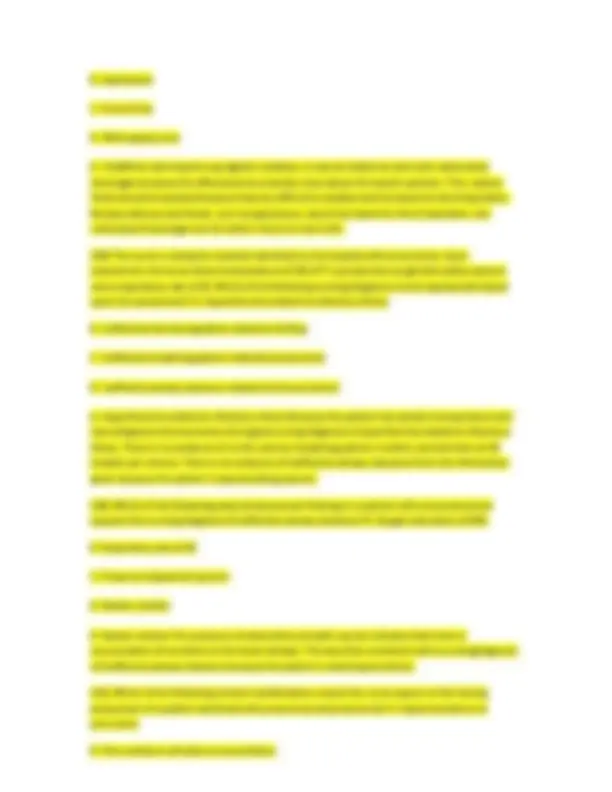
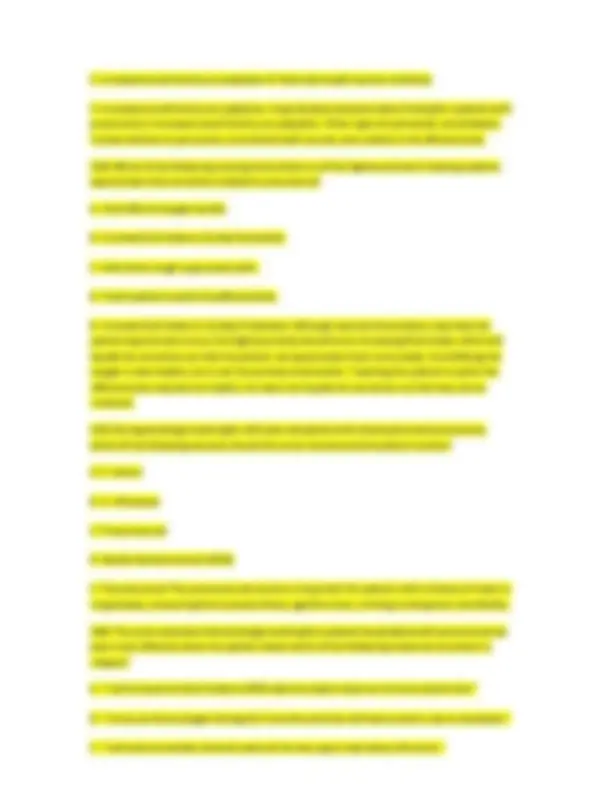
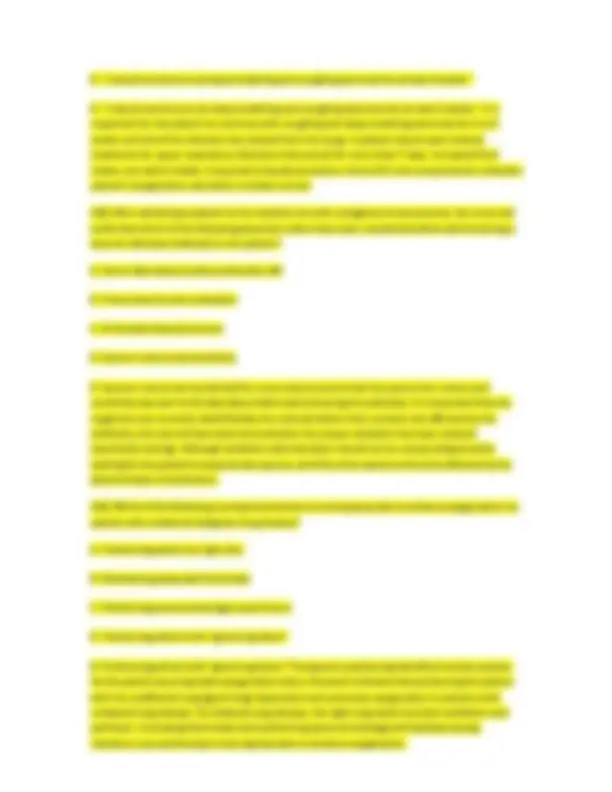
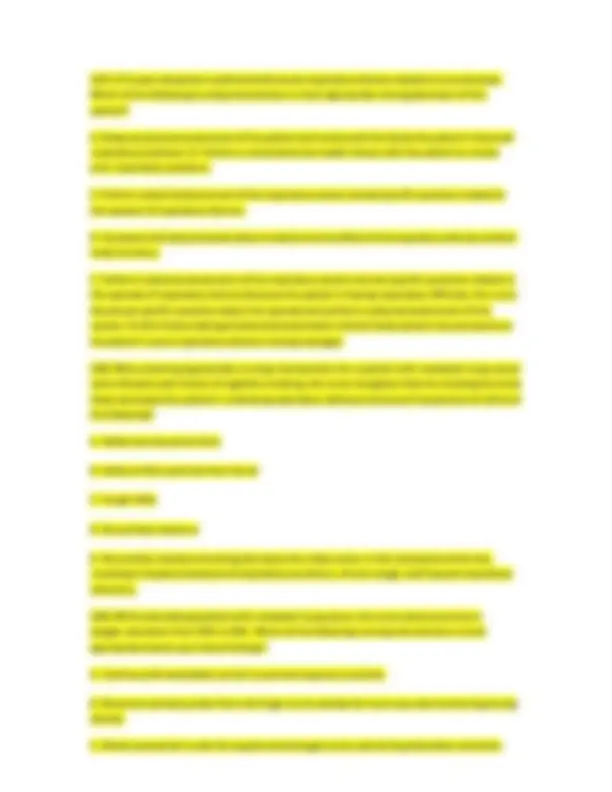
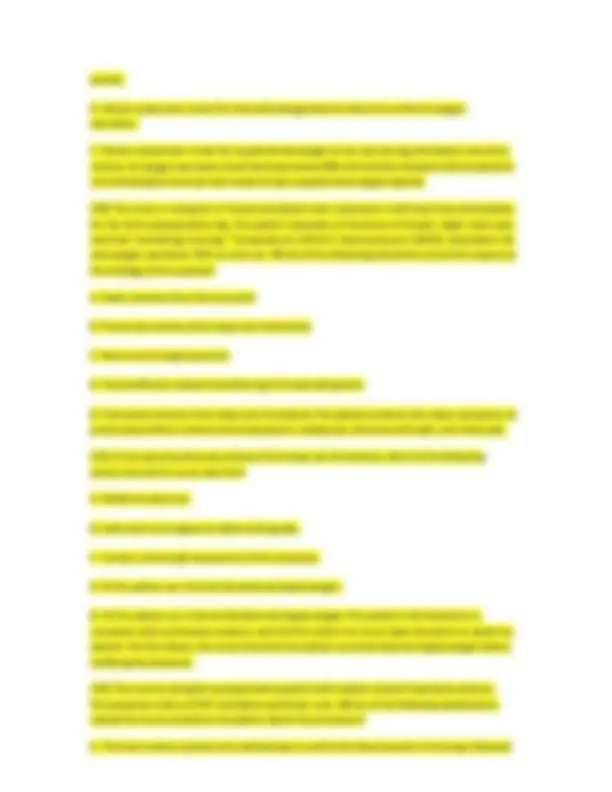
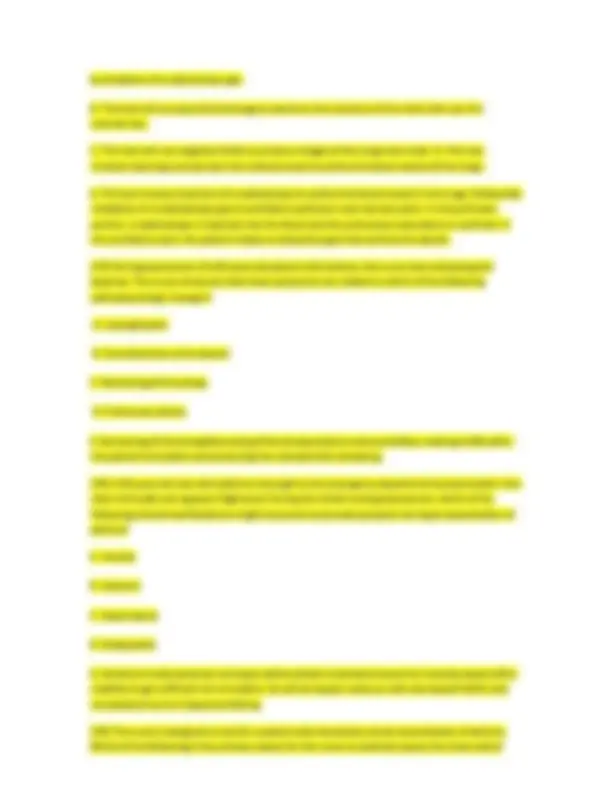
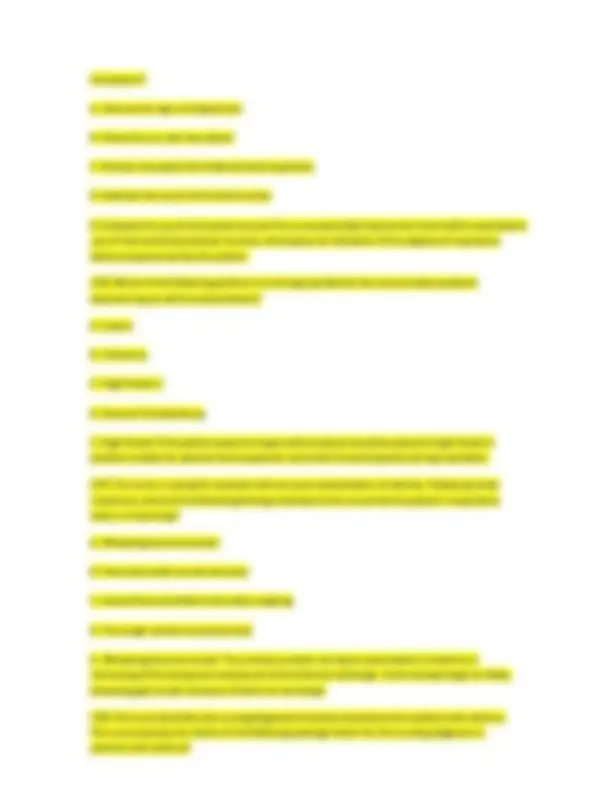
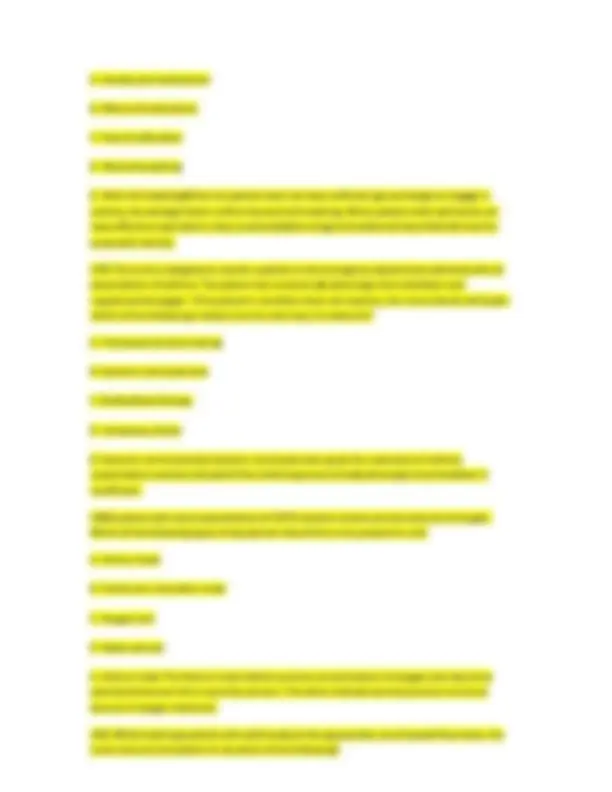
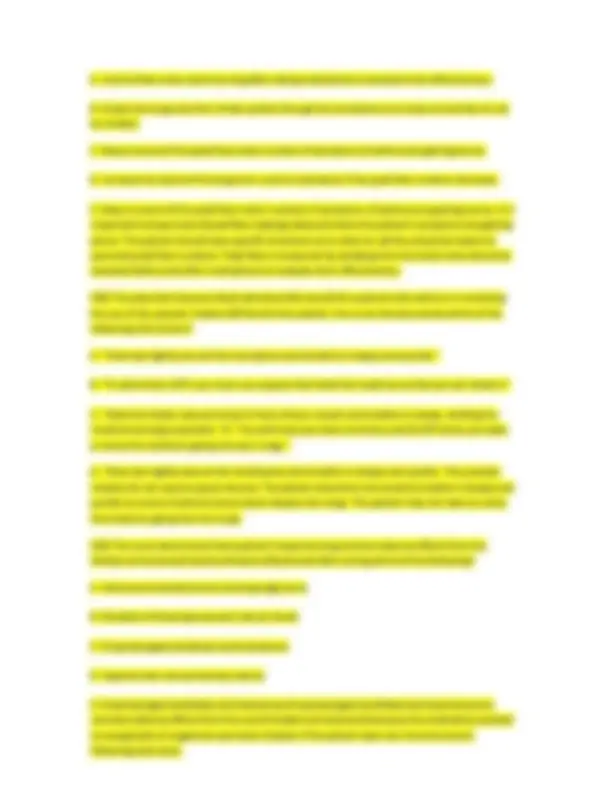
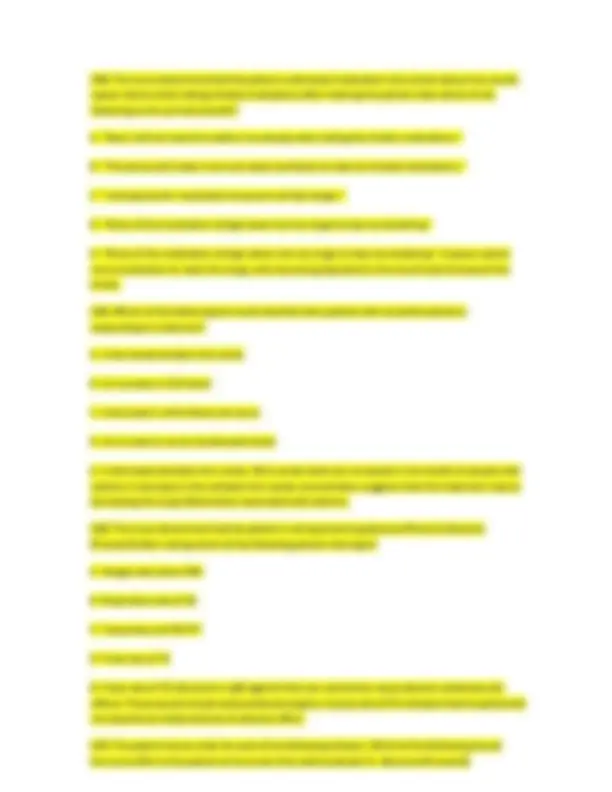
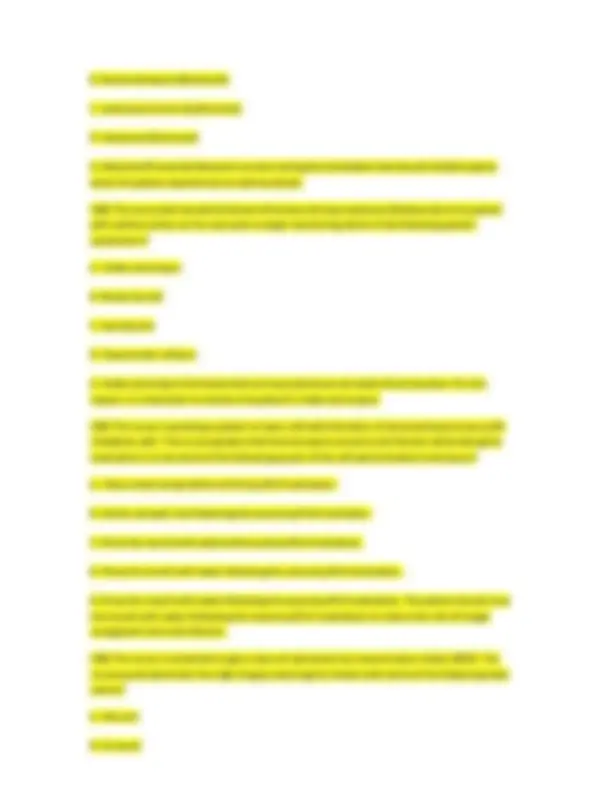
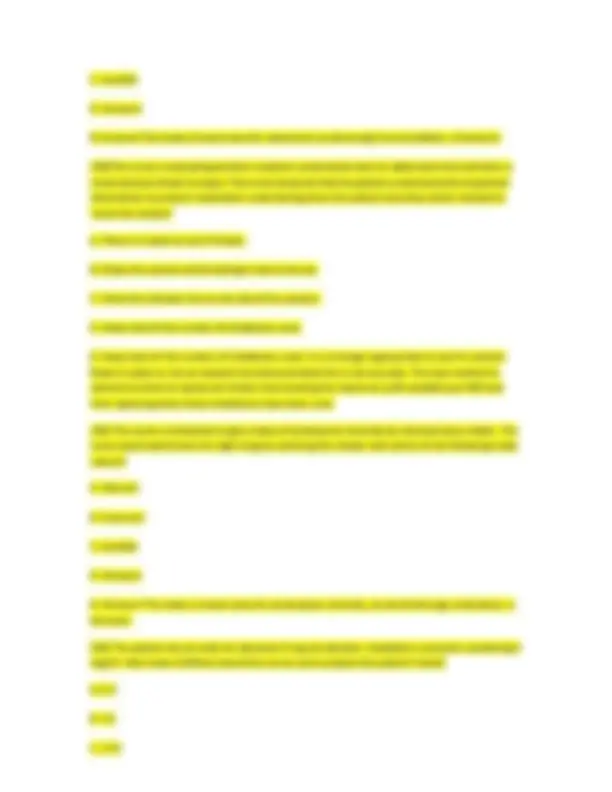
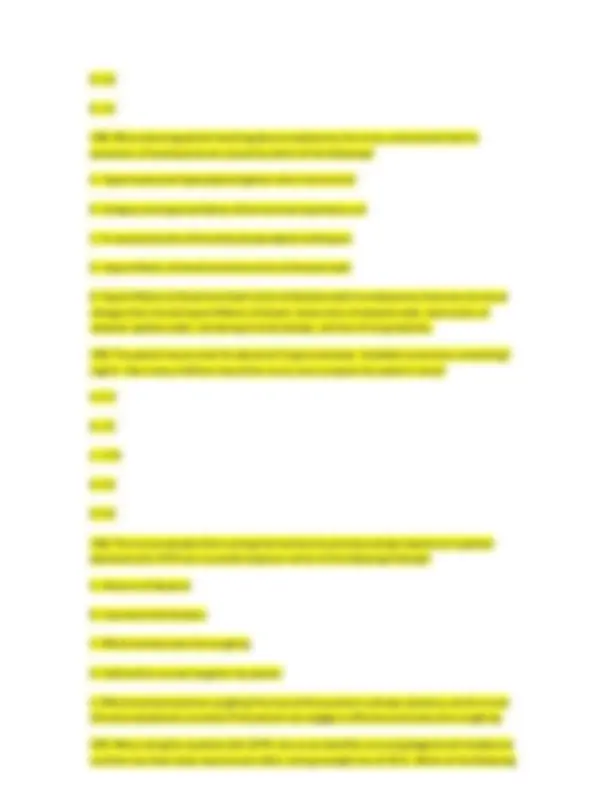

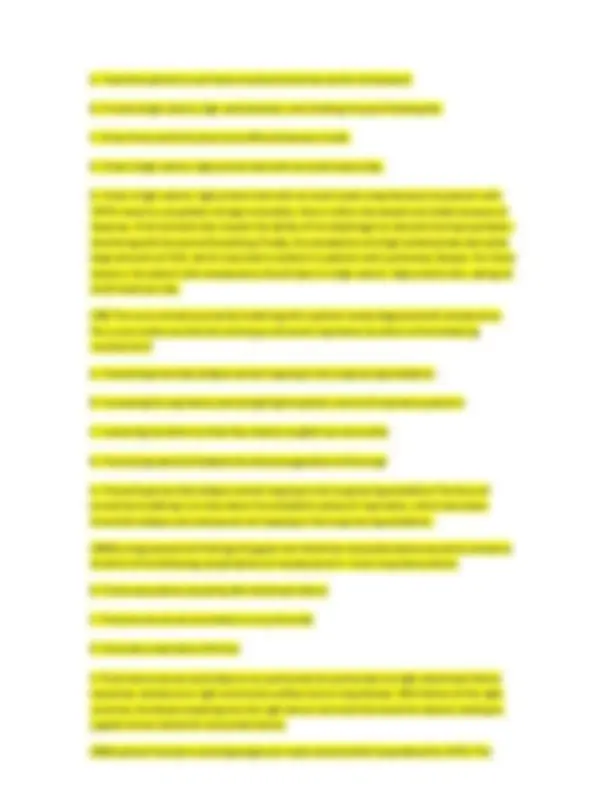
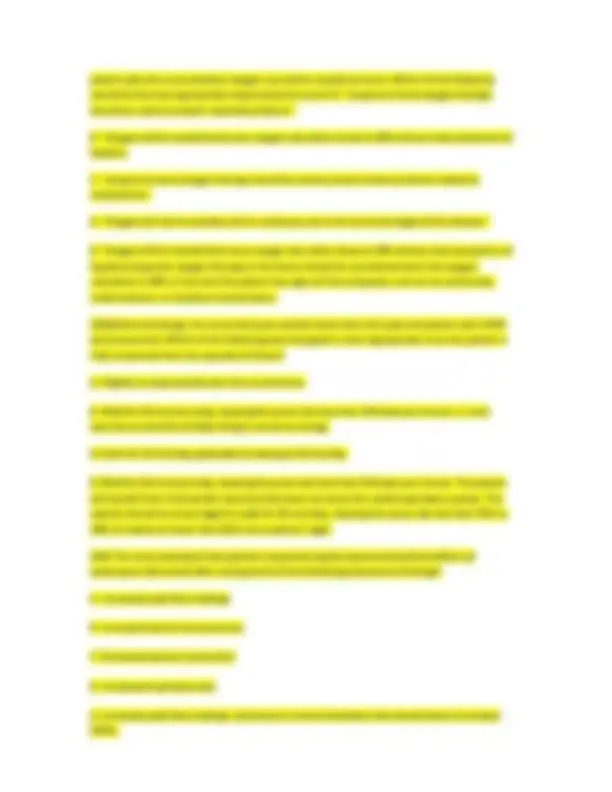
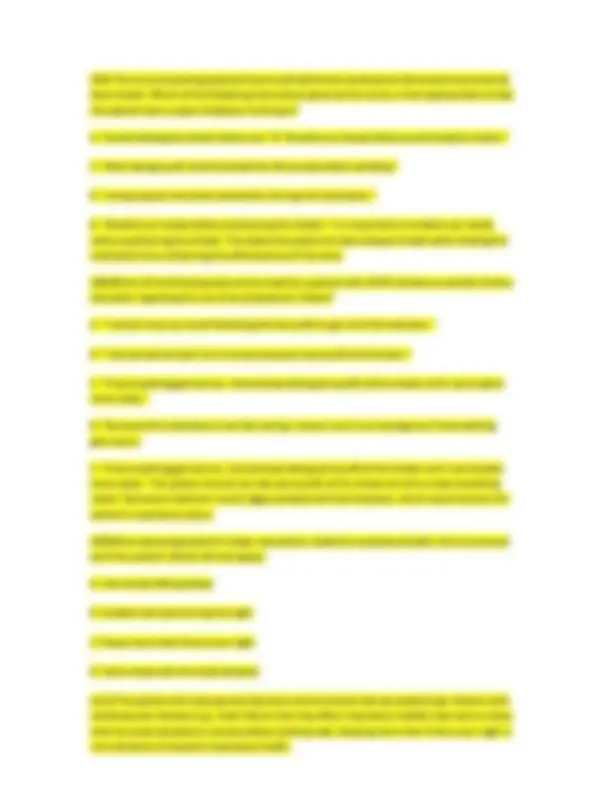
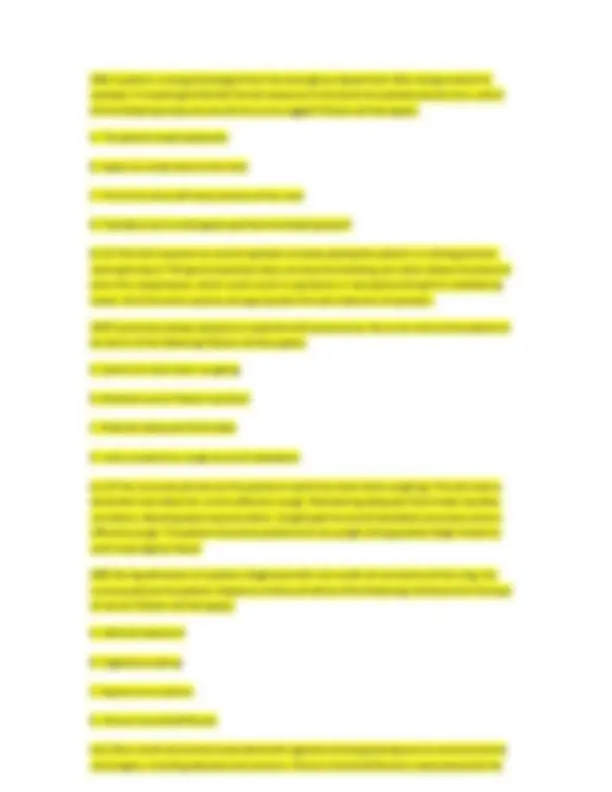
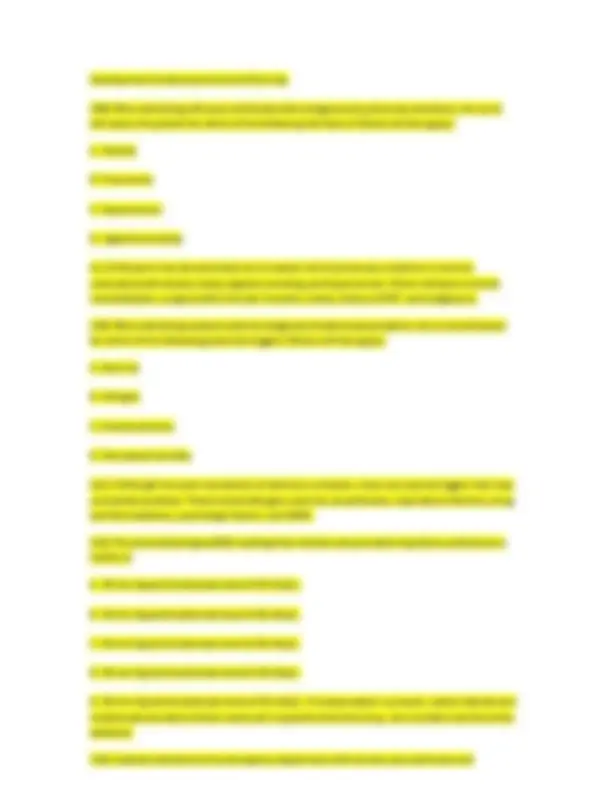
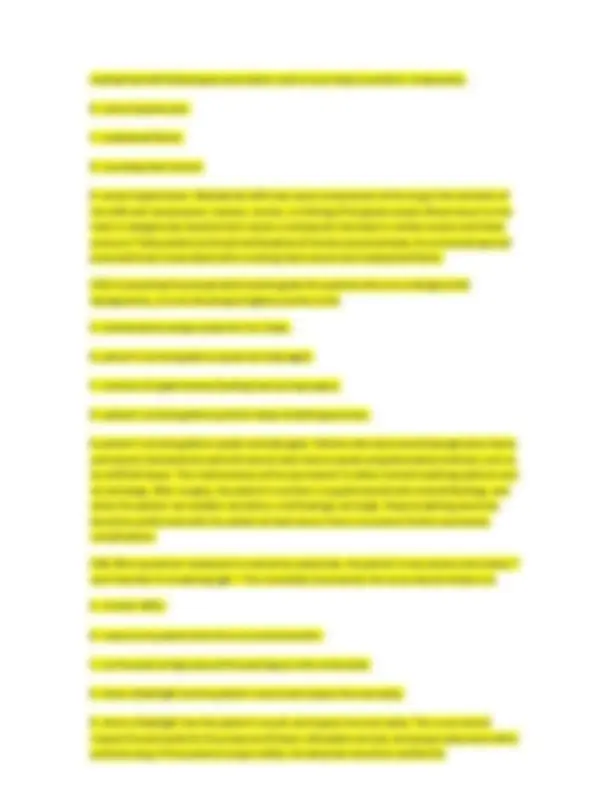
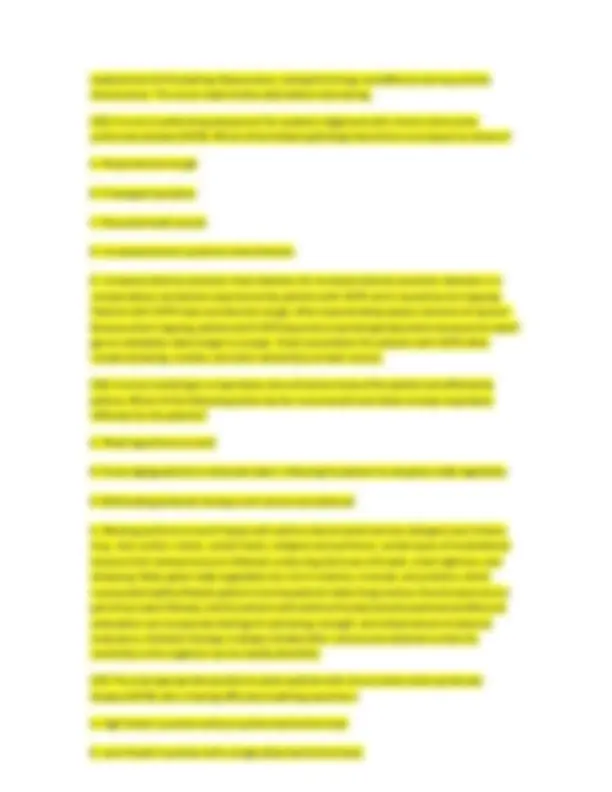
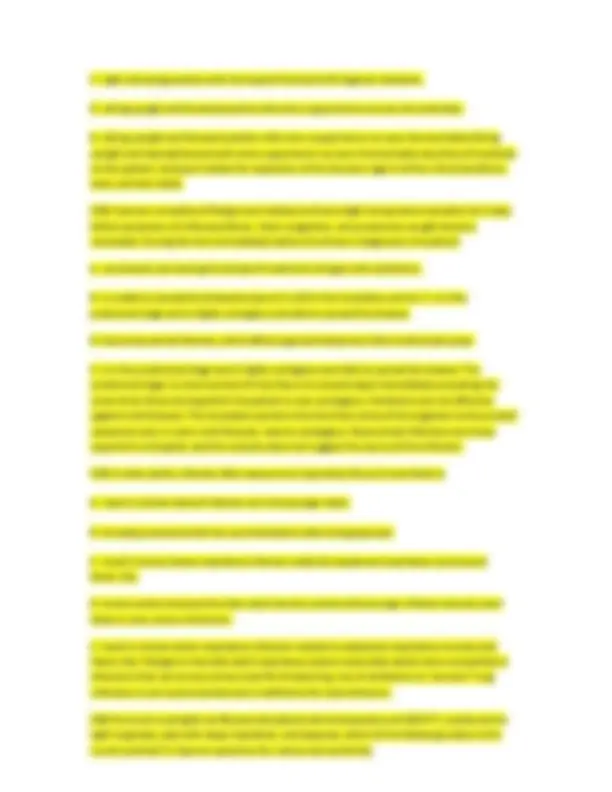
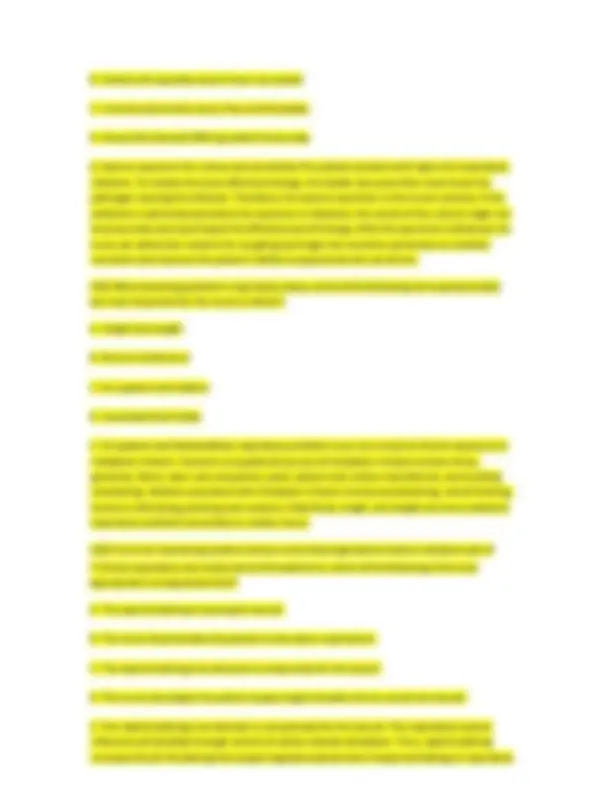
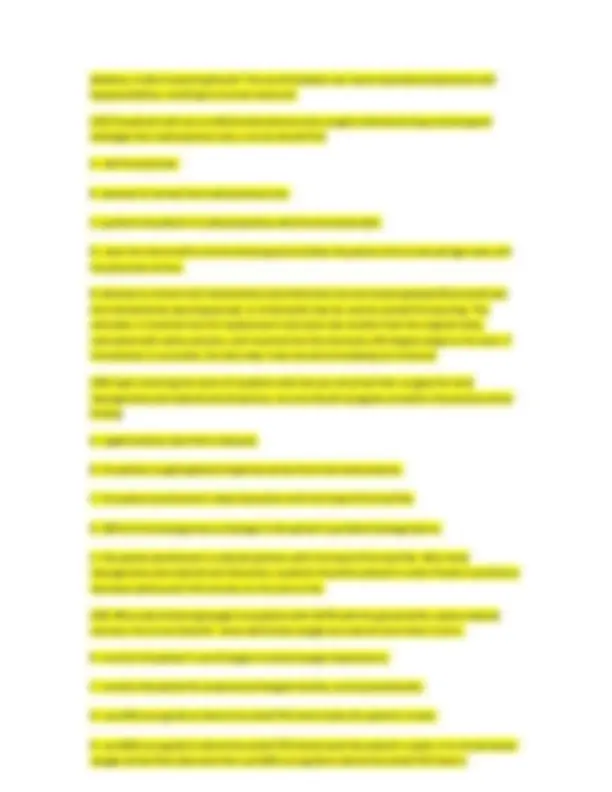
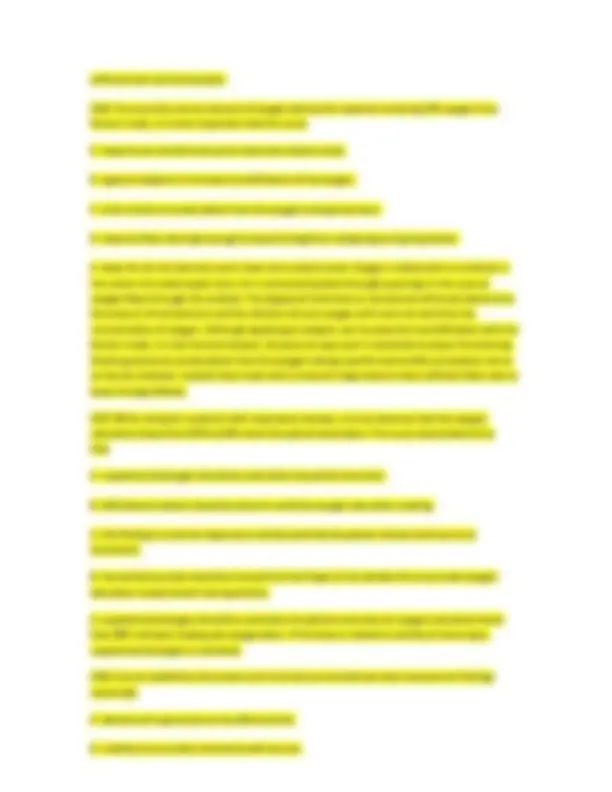
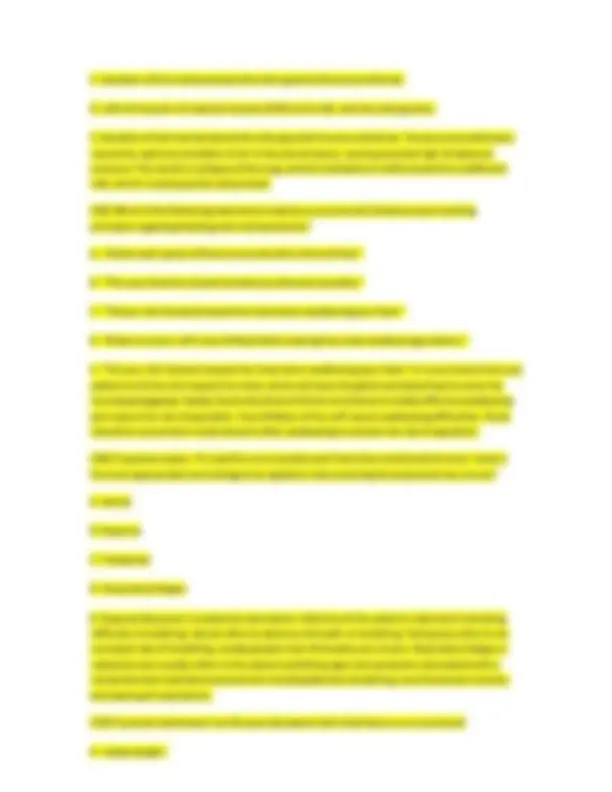
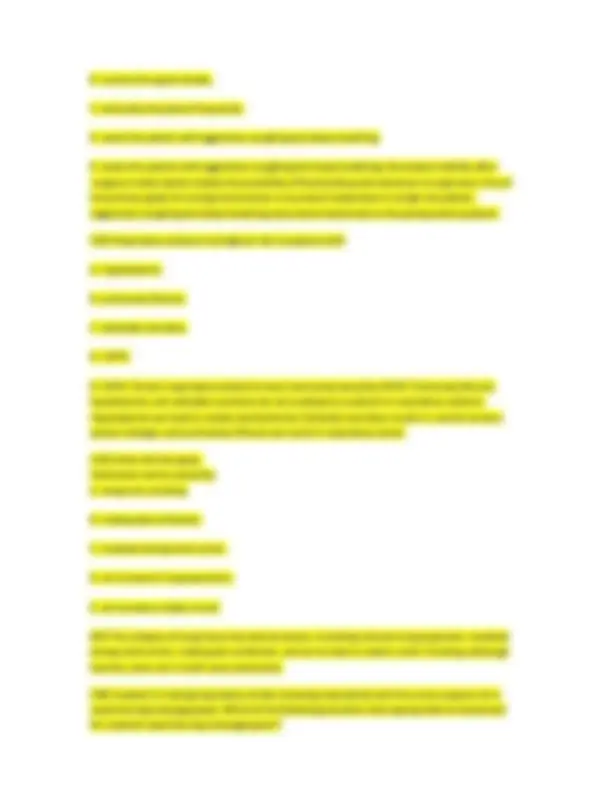
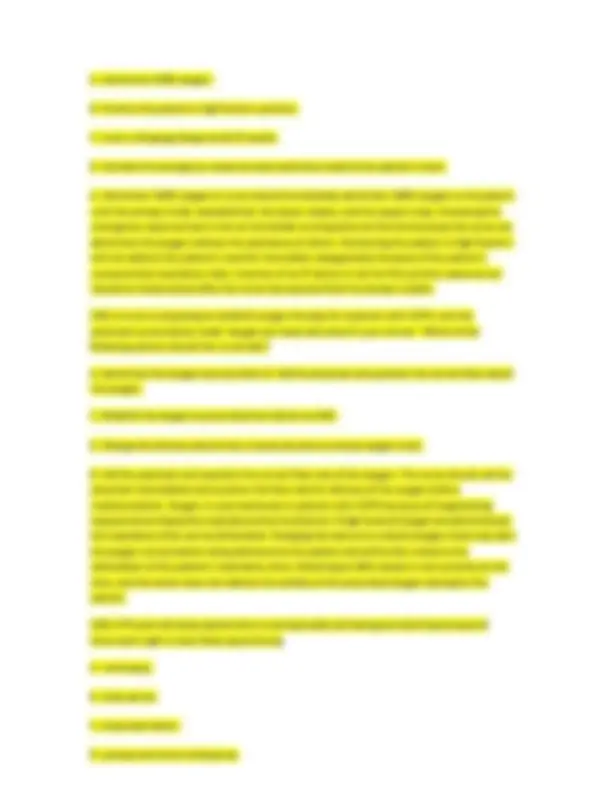
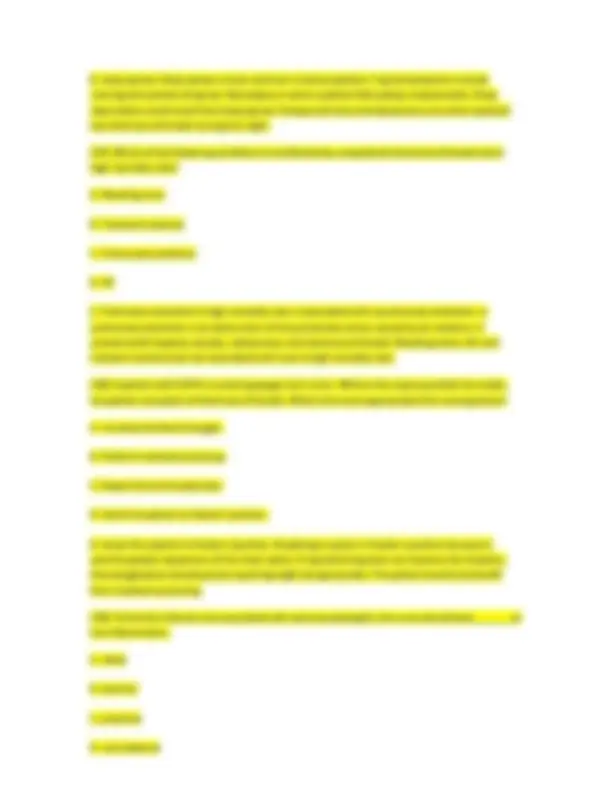
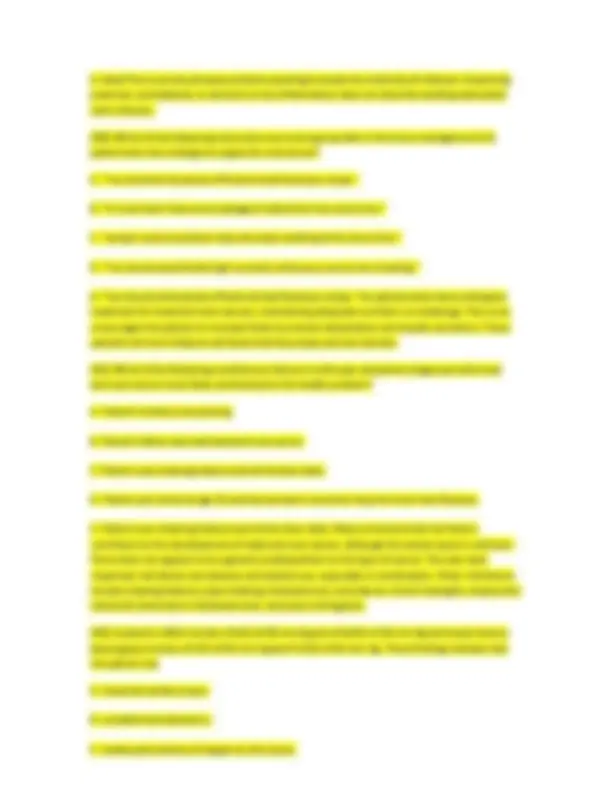
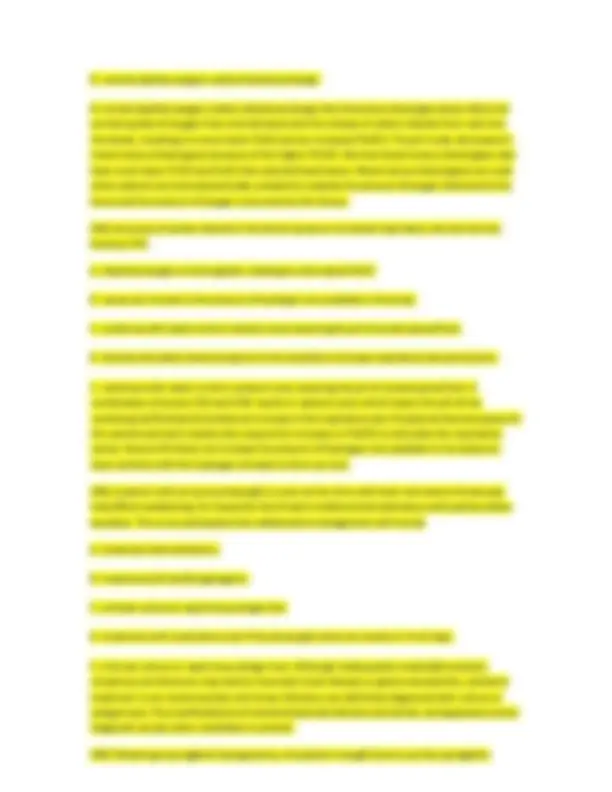
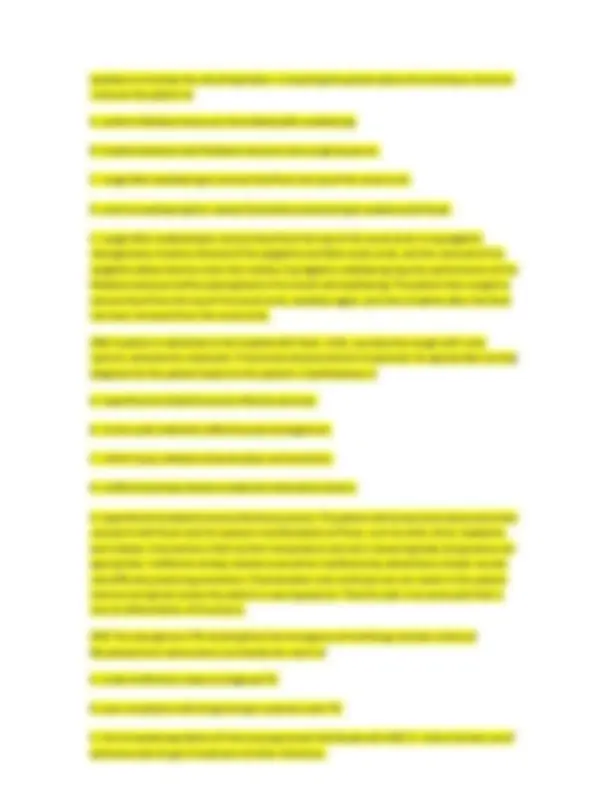
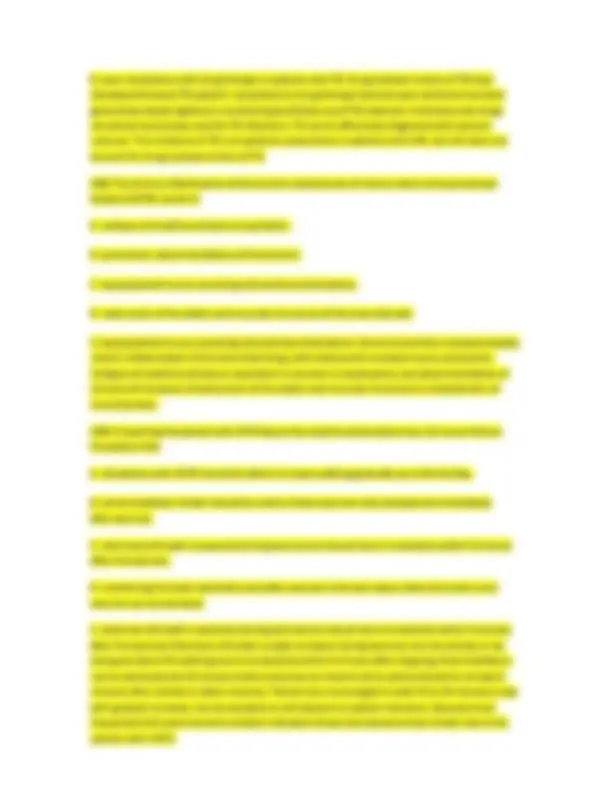



Study with the several resources on Docsity

Earn points by helping other students or get them with a premium plan


Prepare for your exams
Study with the several resources on Docsity

Earn points to download
Earn points by helping other students or get them with a premium plan
Community
Ask the community for help and clear up your study doubts
Discover the best universities in your country according to Docsity users
Free resources
Download our free guides on studying techniques, anxiety management strategies, and thesis advice from Docsity tutors
HESI MED SURG EXAM. QUESTIONS AND ANSWERS.LATEST 2021. A+ RATED.1).pdf
Typology: Exams
1 / 61

This page cannot be seen from the preview
Don't miss anything!






















































A. Hypokalemia B. Microalbuminauria C. Elevated iserum ilipids D. Ketonuria B. iMicroalbuminuria iis ithe iearliest isign iof inephropathy iand iindicates ithe ineed ifor ifollow-up ievaluation. iHyperkalemia i(A) iis iassociated iwith iend istage irenal idisease icaused iby idiabetic inephropathy. i(C) imay ibe ielevated iin iend istage irenal idisease. i(D) imay isignal ithe ionset iof iDKA.
becomes iangry iand iyells iat ithe inurse. i"Get iout iof ihere! iI'll iget iup iwhen iI'm iready." iWhich iresponse ishould ithe inurse iprovide? A. "Your ihealthcare iprovider ihas iprescribed iambulation ion ithe ifirst ipostoperative iday." B. "You imust iambulate ito iavoid iserious icomplications ithat iare imuch imore ipainful." C. "I iknow ihow iyou ifeel; iyou're iangry iabout ihaving ito ido ithis, ibut iit iis irequired." D. "I'll ibe iback iin i 30 iminutes ito ihelp iyou iget iout iof ibed iand iwalk iaround ithe iroom." D. iReturning iin i 30 iminutes iprovides ia icooling ioff iperiod, iis ifirm, idirect, inonthreatening, iand iavoids iargument iwith ithe iclient. iB iis ithreatening. iC. iassumes iwhat ithe iclient iis ifeeling. iA. iavoids ithe inurse's iresponsibility ito iambulate ithe iclient.
accurate iinformation iabout ithis ivaccine? A. "The ivaccine iis igiven iannually ibefore ithe iflue iseason ito ithose iover i 50 iyears iof iage." B. "The iimmunization iis iadministered ionce ito iolder iadults ior ipersons iwith ia ihistory iof ichronic iillness." C. "The ivaccine iis ifor iall iages iand iis igiven iprimarily ito ithose iperson itraveling ioverseas ito iinfected iareas." D. "The ivaccine iwill iprevent ithe ioccurrence iof ipneumococcal ipneumonia ifor iup ito i 5 iyears." B. iIt iis iusually irecommended ithat ipersons iover i 65 iyears iof iage iand ithose iwith ia ihistory iof ichronic iillness ishould ireceive ithe ivaccine ionce iin ia ilifetime. i(A) ithe iinfluenza ivaccine iis igiven iannually. i(C) itravel iis inot ithe imain irationale ifor ithe ivaccine. i(D) iThe ivaccine iis iusually igiven ionceiin ia ilifetime. 14)A iclient iwith ihypertension ihas ibeen ireceiving iramipril i(Altace) i 5 img iPO idaily ifor i 2 iweeks iandiis ischeduled ito ireceive ia idose iat i0900. iAt i 0830 ithe iclient's iblood ipressure iis i120/70. iWhich iaction ishould ithe inurse itake? A. Administer ithe idose ias iprescribed. B. Hold ithe idose iand icontact ithe ihealthcare iprovider. C. Hold ithe idose iand irecheck ithe iblood ipressure iin i 1 ihour. D. Check ithe ihealthcare iprovider's iprescription ito iclarify ithe idose. A. iThe iBP iis iWNL iand iindicates ithat ithe imedication iis iworking. i(B i& iC) iwould ibe iindicated iif itheiBP iwas ilow i(systole ibelow i100). i(D) iis inot irequired ibecause ithe idose iis iwithin imanufacture's irecommendations. 15)The inurse iknow ithat inormal ilab ivalues iexpected ifor ian iadult imay ivary iin ian iolder iclient. iWhich idata iwould ithe inurse iexpect ito ifind iwhen ireviewing ilaboratory ivalues iof ian i 80 - year-old iman iwho iis iin igood ioverall ihealth. A. Complet iblood icount ireveals iincreased iWBC iand idecreased iRBC icounts. B. Chemistries ireveal ian iincreased iserum ibilirubin iwith islightly iincreased iliver ienzymes. C. Urinalysis ireveals islight iprotein iin ithe iurine iand ibacteriuria iwith ipyuria. D. Serum ielectrolytes ireveal ia idecreased isodium ilevel iwith ian iincreased ipotassium ilevel. C. iIn iolder iadults ithe iprotein ifound iin iurine iis islightly irisen ias ia iresult iof ikidney ichanges ior isubclinical iUTIs iand ithe iclient ifrequently iexperiences iasymptomatic ibacteriuria iand ipyuria ias ia iresult iof iincomplete ibladder iemptying. i(A, iB, iD) iare inot inormal ifindings.
D. Social iisolation irelated ito iinability ito icommunicate. A. iTo iincrease ithe iclient's itolerance iof ithe iendotracheal iintubation iand/or imechanical iventilation, ia iskeletal-muscle irelaxant isuch ias ivecuronium iis iusually iprescribed. i(A) iis ia iserious ioutcome ibecause ithe iclient icannot icommunicate ihis/her ineeds. i(D) iis inot ias imuch iof ia ipriority. (B) infection iis inot irelated ito iICP. i(C) iis iincorrect ibecause ithe iventilator iwill iensure ithat ithe ilungs iare iexpanded. 20)The inurse iis ireviewing ithe iroutine imedications itaken iby ia iclient iwith ichronic iangle iclosure iglaucoma. iWhich imedication iprescription ishould ithe inurse iquestion? A. An iantianginal iwith ia itherapeutic ieffect iof ivasodilation. B. An ianticholinergic iwith ia iside ieffect iof ipupillary idilation. C. An iantihistamine iwith ia iside ieffect iof isedation. D. A icorticosteroid iwith ia iside ieffect iof ihyperglycemia. B. iClients iwith iangle iclosure iglaucoma ishould inot itake imedications ithat idilate ithe ipupil i(B) ibecause ithis ican iprecipitate iacute iand iseverely iincreased iintraocular ipressure. i(A, iC, iD) ido inot icause iincreased iintraocular ipressure, iwhich iis ithe iprimary iconcern. 21)What iis ithe icorrect ilocation ifor ithe iplacement iof ithe ihand ifor imanual ichest icompressions iduring iCPR ion ithe iadult iclient. A. Just iabove ithe ixiphoid iprocess ion ithe iupper ithird iof ithe isternum. B. Below ithe ixiphoid iprocess imidway ibetween ithe isternum iand ithe iumbilicus. C. Just iabout ithe ixiphoid iprocess ion ithe ilower ithird iof ithe isternum. D. Below ithe ixiphoid iprocess imidway ibetween ithe isternum iand ithe ifirst irib. iAns: iC 22)Twelve ihours iafter ichest itube iinsertion ifor ihemothorax, ithe inurse inotes ithat ithe iclient's idrainage ihas idecreased ifrom i 50 iml/hr ito i 5 iml/hr. iWhat iis ithe ibest iinital iaction ifor ithe inurse ito itake? A. Document ithis iexpected idecrease iin idrainage. B. Clamp ithe ichest itube iwhile iassessing ifor iair ileaks. C. Milk ithe itube ito iremove iany iexcessive iblood iclot ibuild iup. D. Assess ifor ikinks ior idependent iloops iin ithe itubing.
D. iThe ileast iinvasive iaction ishould ibe iperformed ito iassess ithe idecrease iin idrainage. i(A) iis icompleted iafter iassessing ifor iand iproblems icausing ithe idecreased idrainage. i(B) iis ino ilonger iprotocol ibecause ithe iincreased ipressure imay ibe iharmful ifor ithe iclient. i(C) iis ian iappropriate inursing iaction iafter ithe itube ihas ibeen iassessed ifor ikinks ior idependent iloops. 23)A i 25 - year-old iclient iwas iadmitted iyesterday iafter ia imotor ivehicle icollision. iNeurodiagnostic istudies ishowed ia ibasal iskull ifracture iin ithe imiddle ifossa. iAssessment ion iadmission irevealed iboth ihalo iand iBattle isigns. iWhich inew isymptom iindicates ithat ithe iclient iis ilikely ito ibe iexperiencing ia icommon ilife-threatening icomplication iassociated iwith ibasal iskull ifracture? A. Bilateral ijugular ivein idistention. B. Oral itemperature iof i 102 idegrees iF. C. Intermittent ifocal imotor iseizures. D. Intractable ipain iin ithe icervical iregion. B. iIncreased itemp iindicates imeningitis. i(C i& iD) ithese isymptoms imay ibe iexhibited ibut iare inot ilife ithreatening. i(A) iJVD iis inot ia itypical icomplication iof ibasal iskull ifractures. 24)Seconal i0.1 igram iPRN iat ibedtime iis iprescribed ifor irest. iThe iscored itablets iare ilabeled igrain 1.5 iper itablet. iHow imany itablets ishould ithe inurse iplan ito iadminister? A. 1/2 itablet B. 1 itablet C. 1 i1/2 itablet D. 2 itablets B. i 15 igr i= i 1 ig, i0.1 ix i 15 i= i1.5 igrains 25)Which icontent iabout iself-care ishould ithe inurse iinclude iin ithe iteaching iplan iof ia iclient iwho ihas igenital iherpes? i(Select iall ithat iapply.) A. Encourage iannual iphysical iand iPap ismear. B. Take iantiviral imedication ias iprescribed. C. Use icondoms ito iavoid itransmission ito iothers. D. Warm isitz ibaths imay irelieve iitching. E. Use iNystatin isuppositories ito icontrol iitching. F. Douche iwith iweak ivinegar isolutions ito idecrease iitching.
29)In iassessing ian iolder iclient iwith idementia ifor isundowning isyndrome, iwhat iassessment itechnique iis ibest ifor ithe inurse ito iuse? A. Observe ifor itiredness iat ithe iend iof ithe iday. B. Perform ia ineurologic iexam iand imental istatus iexam. C. Monitor ifor imedication iside ieffects. D. Assess ifor idecreased igross imotor imovement. A. iSundowning isyndrome iis ia ipattern iof iagitated ibehavior iin ithe ievening, ibelieved ito ibe iassociated iwith itiredness iat ithe iend iof ithe iday icombined iwith ifewer iorienting istimuli, isuch ias iactivities iand iinteractions. i(B, iC, i& iD) iwith inot iprovide iinformation iabout ithis isyndrome. 30)Which icondition ishould ithe inurse ianticipate ias ia ipotential iproblem iin ia ifemale iclient iwith ia ineurogenic ibladder? A. Stress iincontinence. B. Infection. C. Painless, igross ihematuria. D. Peritonitis. B. iInfection iis ithe imajor icomplication iresulting ifrom istasis iof iurine iand isubsequent icatheterization. i(A) iis ithe iinvoluntary iloss iof iurine ithrough ian iintact iurethra ias ia iresult iof isuddenly iincreased ipressure. i(C) iis ithe imost icommon isymptom iof ibladder icancer. i(D) iis itheimost icommon iand iserious icomplication iof iperitoneal idialysis. 31)The inurse iis iinterviewing ia iclient iwho iis itaking iinterferon-alfa-2a i(Roferon-A) iand iribavirin i(Virazole) icombination itherapy ifor ihepatitis iC. iThe iclient ireports iexperiencing ioverwhelming ifeelings iof idepression. iWhat iaction ishould ithe inurse iimplement ifirst? A. Recommend imental ihealth icounseling. B. Review ithe imedications iactions iand iinteractions. C. Assess ifor ithe iclient's idaily iactivity ilevel. D. Provide iinformation iregarding ia isupport igroup. B. iAlpha-interferon iand iribavirin icombination itherapy ican icause isevere idepression. i(A, iB, iC) imayibe iimplemented iafter iphysiological iaspect iof ithe isituation iare iassessed. 32)The inurse iis iassessing ia i 75 - year-old imale iclient ifor isymptoms iof ihyperglycemia. iWhich isymptom iof ihyperglycemia iis ian iolder iadult imost ilikely ito iexhibit?
A. Polyuria B. Polydipsia C. Weight iloss D. Infection D. iS/Sx iof ihyperglycemia iin iolder iadults imay iinclude ifatigue, iinfection, iand ineuropathy i(such ias isensory ichanges). i(A, iB, iC) iare iclassic isymptoms iand imay ibe iabsent iin ithe iolder iadult. 33)A iclient iwho iis ireceiving ian iACE iinhibitor ifor ihypertension icalls ithe iclinic iand ireports ithe irecent ionset iof ia icough ito ithe inurse. iWhat iaction ishould ithe inurse iimplement? A. Advise ithe iclient ito icome ito ithe iclinic iimmediately ifor ifurther iassessment. B. Instruct ithe iclient ito idiscontinue iuse iof ithe idrug, iand imake ian iappointment iat ithe iclinic. C. Suggest ithat ithe iclient ilear ito iaccept ithe icough ias ia iside ieffect ito ia inecessary iprescription. D. Encourage ithe iclient ito ikeep itaking ithe idrug iuntil iseen iby ithe iHCP. D. iCough iis ia icommon is/e iof iACE iinhibitors iand iis inot ian iindication ito idiscontinue ithe imedication. i(A) iimmediate ievaluation iis inot ineeded. i(B) ian iantihypertensive ishould inot ibe istopped iabruptly. i(C) iis idemeaning isince ithe icough imay ibe idisruptive ito ithe iclient iand iother imedications imay iproduce iresults iwithout ithe is/e. 34)The inurse iis iobserving ian iunlicensed iassistive ipersonnel i(UPA) iwho iis iperforming imorning icare ifor ia ibedfast iclient iwith iHuntington idisease. iWhich icare imeasure iis imost iimportant ifor ithe inurse ito isupervise? A. Oral icare B. Bathing C. Foot icare D. Catheter icare A. iA iclient iwith iHuntington idisease iexperiences iproblems iwith imotor iskills isuch ias iswallowingiand iis iat ihigh irisk ifor iaspiration. i(B, iC, iD) ido inot ipose ilife-threatening iconsequences. 35)A iclient iwith ialcohol-related iliver idisease iis iadmitted ito ithe iunit. iWhich iprescription ishould ithe inurse iquestion ias ipossibly iinappropriate ifor ithe iclient? A. Vitamin iK1 i(AquaMEPHYTON) i 5 img iIM idaily B. High-calorie, ilow-sodium idiet
C. Malignant imelanoma D. Squamous-cell icarcinoma A. iis ithe ionly ilung icancer inot irelated ito icigarette ismoking irelated ito ilung iscarring iand ifibrosis ifrom ipreexisting ipulmonary idiseases isuch ias iTB iand iCOPD. i(B& iD) iare irelated ito ismoking. i(C) iisia iskin icancer 39)The inurse iis icaring ifor ia iclient iwith ia ichest itube ito iwater iseal idrainage ithat iwas iinserted i 10 idays iago ibecause iof ia iruptured ibullae iand ipneumothorax. iWhich ifinding ishould ithe inurse ireport ito ithe ihealthcare iprovider ibefore ithe ichest itube iis iremoved? A. Tidal iof iwater iin ithe iwater iseal ichamber B. Bilateral imuffled ibreath isounds iat ibases C. Temperature iof i 101 idegrees iF D. Absence iof ichest itube idrainage ifor i 2 idays. A. iTidal iin ithe iwater iseal ichamber ishould ibe ireported ito ithe iHPC ito ishow ithat ithe ichest itube iis iworking iproperly. i(B) imay iindicate ihypoventilation ifrom ithe ichest itube iand iusually iimproves iwhen ithe itube iis iremoved. i(C) iindicates iinfection i(D) iis ian iexpected ifinding. 40)A icentral ivenous icatheter ihas ibeen iinserted ivia ia ijugular ivein iand ia iradiography ihas iconfirmed iplacement iof ithe icatheter. iA iprescription ihas ibeen ireceived ifor istat imedication ibut iIV ifluids ihave inot iyet ibeen istarted. iWhat iaction ishould ithe inurse itake iprior ito iadministering ithe iprescribed imedication? A. Assess ifor isigns iof ijugular ivein idistention. B. Obtain ithe ineeded iintravenous isolution. C. Administer ia ibolus iof inormal isaline isolution. D. Flush ithe iline iwith iheparinized isaline. C. iA imedication ican ibe iadministered icentral iline iwithout iIV ifluids, iflush iwith inormal isaline ito iremove iheparin ithat imay icounteract iwith ithe imedication. i(B) iis iused ifollowing ithe imedication iand ia isecond isaline ibolus. i(A) iwill inot iimpact ithe ithe imed iadministration iand iis inot ia ipriority. (B) Administration iof ithe istat imedication iis imore iof ia ipriority ithan i(B). 41)The inurse iassesses ia ipostoperative iclient. iOxygen iis ibeing iadministered iat i 2 iL/min iand ia isaline ilock iis iin iplace. iAssessment ishows icool, ipale, imoist iskin. iThe iclient iis ivery irestless iand ihas iscant iurine iin ithe iurinary idrainage ibag. iWhat iintervention ishould ithe inurse iimplement ifirst. A. Measure iurine ispecific igravity.
B. Obtain iIV ifluids ifor iinfusion iprotocol. C. Prepare ifor iinsertion iof ia icentral ivenous icatheter. D. Auscultate ithe iclient's ibreath isounds. B. iThe iclient iis iat irisk ifor ihypovolemic ishock iand iis iexhibiting iearly isigns. iStart iIV ito irestoreitissue iperfusion. i(A, iC, iD) iare iall iimportant ibut iless iof ia ipriority. 42)A iclient idiagnosed iwith iangina ipectoris icomplains iof ichest ipain iwhile iambulating iin ithe ihallway. iWhich iaction ishould ithe inurse iimplement ifirst? A. Support ithe iclient ito ia isitting iposition. B. Ask ithe iclient ito iwalk islowly iback ito ithe iroom. C. Administer ia isublingual initroglycerin itablet. D. Provide ioxygen ivia inasal icannula. A. iAssist iin isafely irepositioning iand ithen iadminister i(C i& iD). iThen ithe iclient ican ibe iescortediback ito ithe iroom ivia iwheelchair ior istretcher i(B). 43)A i 55 - year-old imale iclient iis iadmitted ito ithe icoronary icare iunit ihaving isuffered ian iacute imyocardial iinfarction i(MI). iWithin i 24 ihours iof ithe ioccurrence, ithe inurse ican iexpect ito ifind iwhich isystemic isign? A. Elevated iserum iamylase ilevel B. Elevated iCM-MB ilevel C. Prolonged iprothrombin itime i(PT) D. Elevated iserum iBUN iand icreatinine B. iTissue idamage iin ithe imyocardium icauses ithe irelease iof icardiac ienzymes iinto ithe iblood isystem. iAn ielevated iCM-MB iis ia irecognized iindicator iof ian iMI. iIt ipeaks i 12 i- i 24 ihours iand ireturnsito inormal iwithin i 48 i- i 78 ihours. i(A) iwould iindicate ipancreatitis ior ia igastric idisorder. i(D) iAlthough ian ielevated iBUN imight ibe irelated ito ian iacute iMI iit iis iusually iassociated iwith idehydration, ihigh iprotein iintake ior igastrointestinal ibleeding iand icreatine ilevels iindicate irenal idamage. i(C) iIndicates ieffective ianticoagulation itherapy. 44)The inurse iis iassessing ia iclient iwho ipresents iwith ijaundice. iWhich iassessment ifinding iis ithe imost isignificant iindication ithat ifurther ifollow iup iis ineeded? A. Urine ispecific igravity iof i1.03 iwith ia iurine ioutput iof i 500 iml iin i 8 ihours B. Frothy, itea-colored iurine
D. Ability ito ispontaneously iopen ithe ieyes ibefore iany itactile istimuli iare igiven. D. iThe iLOC ishould ibe iimmediately iestablished iimmediately iafter ithe ihead iinjury ihas ioccurred. iSpontaneous ieye iopening i(D) iis ia isimple imeasure iof iLOC. i(A) iis inot ithe ibest iindicator iof iLOC. i(B)iis iimportant ibut inot ithe ibest iindicator iof iLOC. i(C) ican ibe iassessed iafter iLOC ihas ibeen iestablished iby iassessing ieye iopening. 48)A i 43 - year-old ihomeless, imalnourished ifemale iclient iwith ia ihistory iof ialcoholism iis itransferred ito ithe iICU. iShe iis iplaced ion itelemetry, iand ithe irhythm istrip ishown iis iobtained. iThe inurse ipalpates ia iheart irate iof i 160 ibeats/min, iand ithe iclient's iblood ipressure iis i90/54. iBased ion ithese ifinding, iwhich iIV imedication ishould ithe inurse iadminister? A. Amiodarone i(Cordarone) B. Magnesium isulfate C. Lidocaine i(Xylocaine) D. Procainamide i(Pronestyl) B. iBecause ithe iclient ihas ichronic ialcoholism, ishe iis ilikely ito ihave ihypomagnesium. i(B) iis ithe irecommended idrug ifor itorsades ide ipointes i(AHA, i2005), iwhich iis ia iform iof ipolymorphic iventricular itachycardia i(VT), iusually iassociated iwith ia iprolonged iQT iinterval ithat ioccurs iwith ihypomagnesemia. i(A iand iD) iincrease ithe iQT iinterval, iwhich ican icause ithe itorsades ito iworsen. (C) is ithe iantiarrhythmic iof ichoice iin imost icases iof idrug-induced imonomorphic iVT, inot itorsades. 49)The inurse iis icaring ifor ia icritically iill iclient iwith icirrhosis iof ithe iliver iwho ihas ia inasogastric itube idraining ibright ired iblood. iThe inurse inotes ithat ithe iclient's iserum ihemoglobin iand ihematocrit iare idecreased. iWhat iadditional ichange iin ilab idata ishould ithe inurse iexpect? A. Increased iserum ialbumin B. Decreased iserum icreatinine C. Decreased iserum iammonia D. Increased iliver ifunction itests C. iThe ibreakdown iof iglutamine iin ithe iintestine iand ithe iincreased iactivity iof icolonic ibacteria ifrom ithe idigestion iof iproteins iincreases ithe iammonia ilevels iin ithe iclients iwith iadvanced iliver idisease, iso iremoval iof iblood, ia iprotein isource, ifrom ithe iintestines iresults iin ireduced iammonia.i(A, iB, iD) iwill inot ibe isignificantly iimpacted iby ithe iremoval iof iblood. 50)A ifamily imember iwas itaught ito isuction ia iclient's itracheostomy iprior ito ithe iclient's idischarge ifrom ithe ihospital. iWhich iobservation iby ithe inurse iindicates ithat ithe ifamily imember iis icapable iof icorrectly iperforming ithe isuctioning itechnique?
A. Turns ion ithe icontinuous iwall isuction ito i- 190 imm iHg B. Inserts ithe icatheter iuntil iresistance ior icoughing ioccurs C. Withdraws ithe icatheter iwhile imaintaining isuctioning D. Re-clears ithe itracheostomy iafter isuctioning ithe imouth B. iindicates icorrect itechnique ifor iperforming isuctioning. iSuction ipressure ishould ibe ibetween
can icause ibone imarrow idepression irheumatoid iarthritis lab=hemaglobin idecrease i=adverse iside ieffect i62)pentobarbital i(Neubatal isodium) icontriandicated iwith iliver idamage i63)cirrhosis Vitamin iK1 i(AquaMephyton) ihigh icalorie, ilow isodium idiet isodium irestriction iw/ iedema fluids irestricted ito idecrease iascites ilate istage i= iascites 64)TPN itotal iprotein inutrition only iregular iinsulin iis iadm. iIV ireturn icontaining iNPH i65)kidney istone strain iall iurine imost iimportant iencourage iurine 66)blunt itrama ito iback iof ihead iLOC iassessment imost iimportant i67)cancer reduce ifats increase ifruits, ivegetables iand ifiber iie ibran iflakes, iskim imilk, iorange islices i68)telemetry ventrical ifibrillation i= ilife ithreatening istart iCPR i69)COPD
contributing ifactor=smoking i70)osteoporosis most icommon icause iof ifractured ihip= ireduced icalcium iin ibones iresult iof ihormonal ichanges iduring iperimenaopausal iyears 71)esophagogastromy iesophageal icancer risk ifor iinfection i= imeticulious ioral icare ishould ibe iprovided iseveral itimes ia iday iprior ito isurgery i72)diverticulitits hard iridgid iabdomen i& ielevated iWBC i= iperitonitis i= imedical iemergency ishould ibe ireported ito iPCP iimmediately s/s ileft ilower iquadrant ipain; ielevated itemperature; irefusing ito ieat; inausea i73)lactulose i(Cephulac) reduce iblood iammonia iby iexcreation iof iammonia iby istoolsi 2 i- 3 isoft istools iper iday 74)IV's iinfusions ipotential iproblems morphine, icontinous iepidural i= irespiratory idepression imagnesium icontinous iinfusion i= ihypotension vancomycin iintermittent iinfusion i= inephrotoxicity i& iphlebitits i75)pancreatitis serium iamylase i& ilipase i 2 ito i 5 itimes ihigher ithan inormal ihypercalcemia i 40 i~ i75% i= ipositive itrousseau isign i= icarpal ispasmisevere iboring ipain 76)hypercalcemia positive itrousseau isign i= icarpal ispasm i77)neurogenic ibladder infection i- ifrom istasis iof iurine iand isubsuquent icatheterization